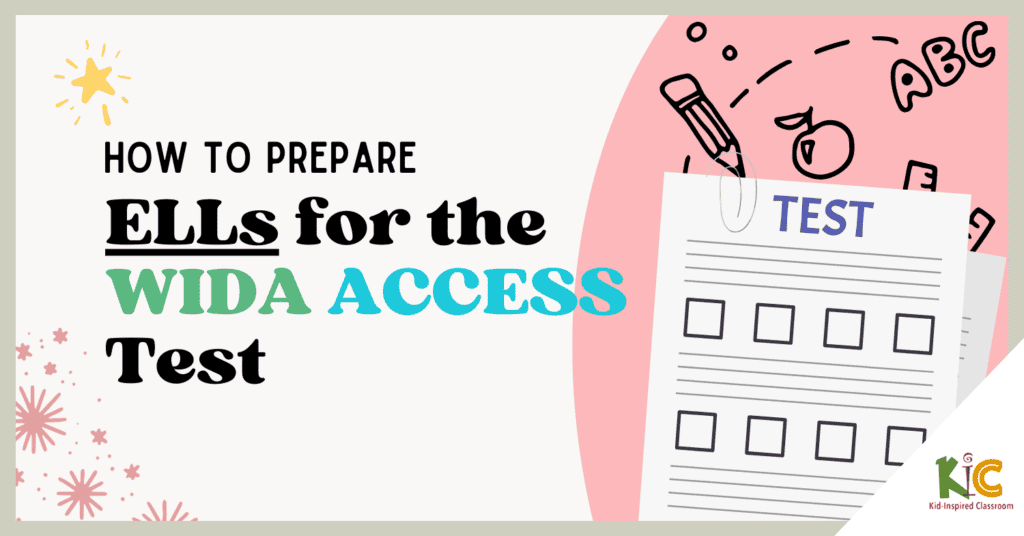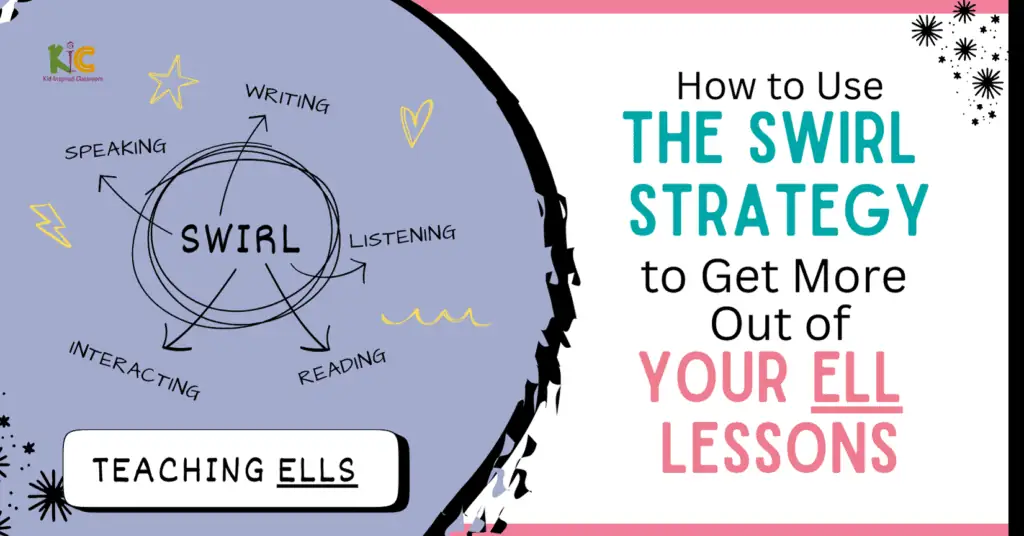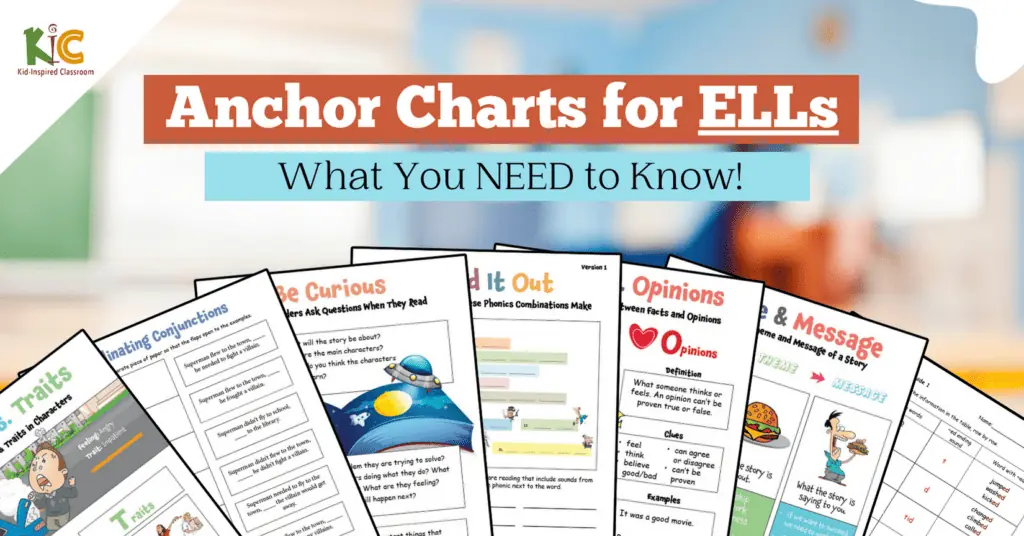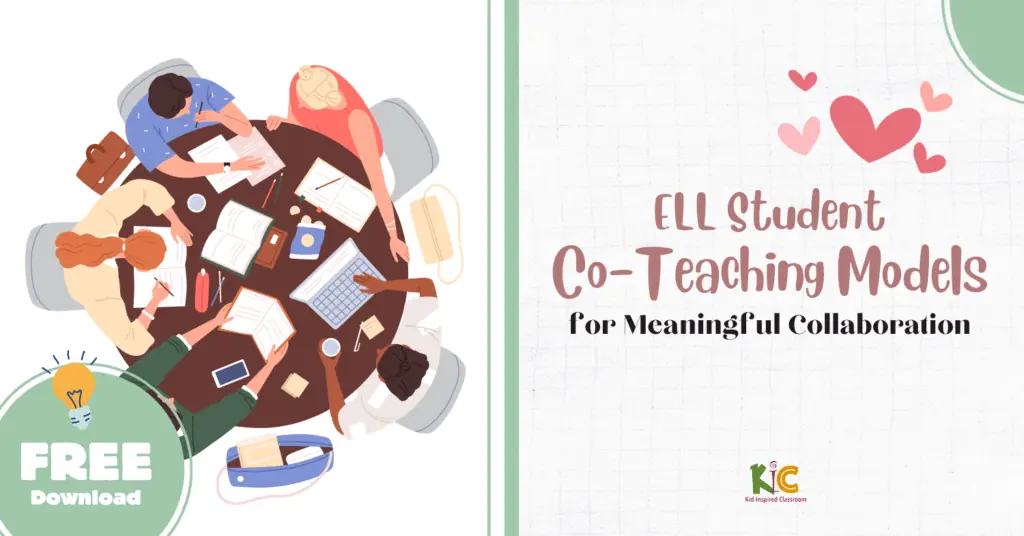

FREE Co-Planning Pack
Click below to grab a FREE Co-Planning Forms Pack for lesson planning with a colleague.
Teachers are awesome. Hands down. No question.
But two teachers in the same room may not always know how to be awesome together.
But they need to find effective ways to collaborate in order to best serve their students’ needs.
Andrea Honigsfeld says, “Teacher collaboration is not an option. It is a must.”
In this article, I’ll provide some research-backed ways to create meaningful collaborative experiences with your co-teaching colleagues.
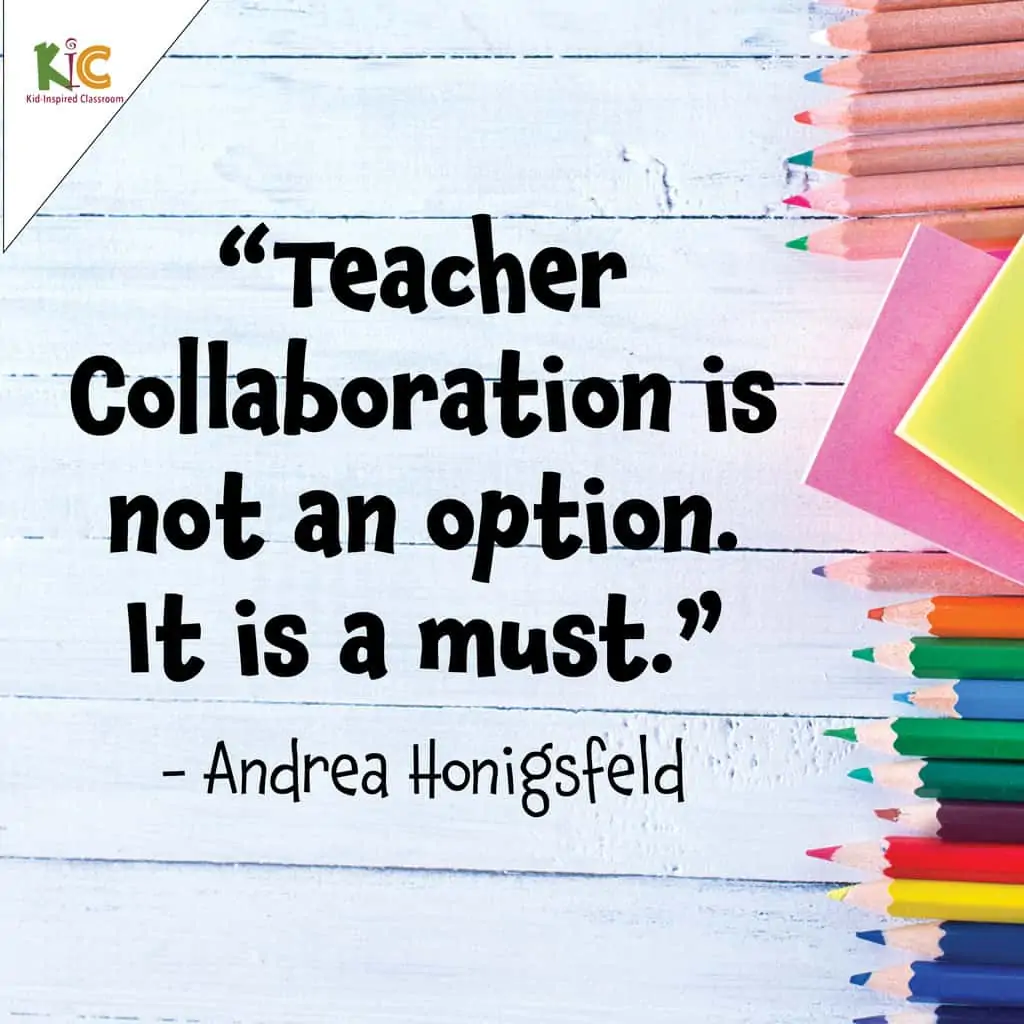
Let’s take a look at how to do it!
In this article:
- Why the Need for Collaboration?
- Models for Meaningful Collaboration
- Working Through Co-Teaching Challenges
- Free C0-Teaching Lesson Planning Resources & More
Why the Need for Collaboration?
First, you might be wondering why the need for co-teaching in the first place.
Many teachers prefer a “pull out” model where they get the students all to themselves and don’t have to deal with all of the challenges of working closely with another teacher.
Unfortunately…
…as helpful as pulling our students out can be, the experience can also disrupt their ability to adapt to their grade-level classes.
Our English learners are usually starting way behind their peers and they need to catch up as quickly as possible.
When we pull them out, the temptation is to mitigate the challenges they face by making the content easier or by going at a slower pace.
Most students are very happy to go more slowly and interact with simpler material, just as the ESL teacher is happier to teach it, but they will not catch up to their peers that way and with each passing semester, they will fall further and further behind their grade level.
That is not to say…
…that we should never have our English learners to ourselves.
There are certainly times when that is appropriate.
- When newcomers first arrive and they are overwhelmed with trying to adapt.
- If your school has WIN (What I Need) blocks of time built into the schedule, you can have “pull out” time with your English learners without causing them to miss out on their regularly scheduled classes.
- If you pull them out, but are still working closely with the grade-level content teacher to make sure they are meeting the same standards. Collaboration does not mean you have to co-teach.
Co-Teaching Models for Meaningful Collaboration
Now that we understand the why…
…let’s take a look at the different models of co-teaching.
We’ll try to sum them up into 3 basic models even though Andrea Honigsfeld covers 6 in her book Co-Teaching for English Learners and there are probably 600 if you start getting into the details.
We’ll first take a bird’s eye look at the different models and then dive into the strengths and weaknesses of each model below.
3 Co-Teaching Models(& a Bonus!)

Batman & Robin
In this model, one teacher leads, and the other teacher assists, like Batman and Robin.
Batman delivers the main content while Robin illustrates, translates, simplifies, observes, or assesses.
Both Batman and Robin are important. Batman couldn’t succeed without Robin and vice versa. Contrary to the silver screen though, in a co-teaching environment, teachers need to take turns being Batman.

Tag-Team
Another model of co-teaching is when both teachers teach the content at the same time, taking turns “tagging each other in” as they go.
This method is also called parallel teaching because both teachers are sharing the teaching at the front.
It’s a little like Thelma and Louise, Rory and Lorelai, Laurel and Hardy.
The two teachers play off each other, filling in gaps, explaining different pieces, finishing each other’s sentences.
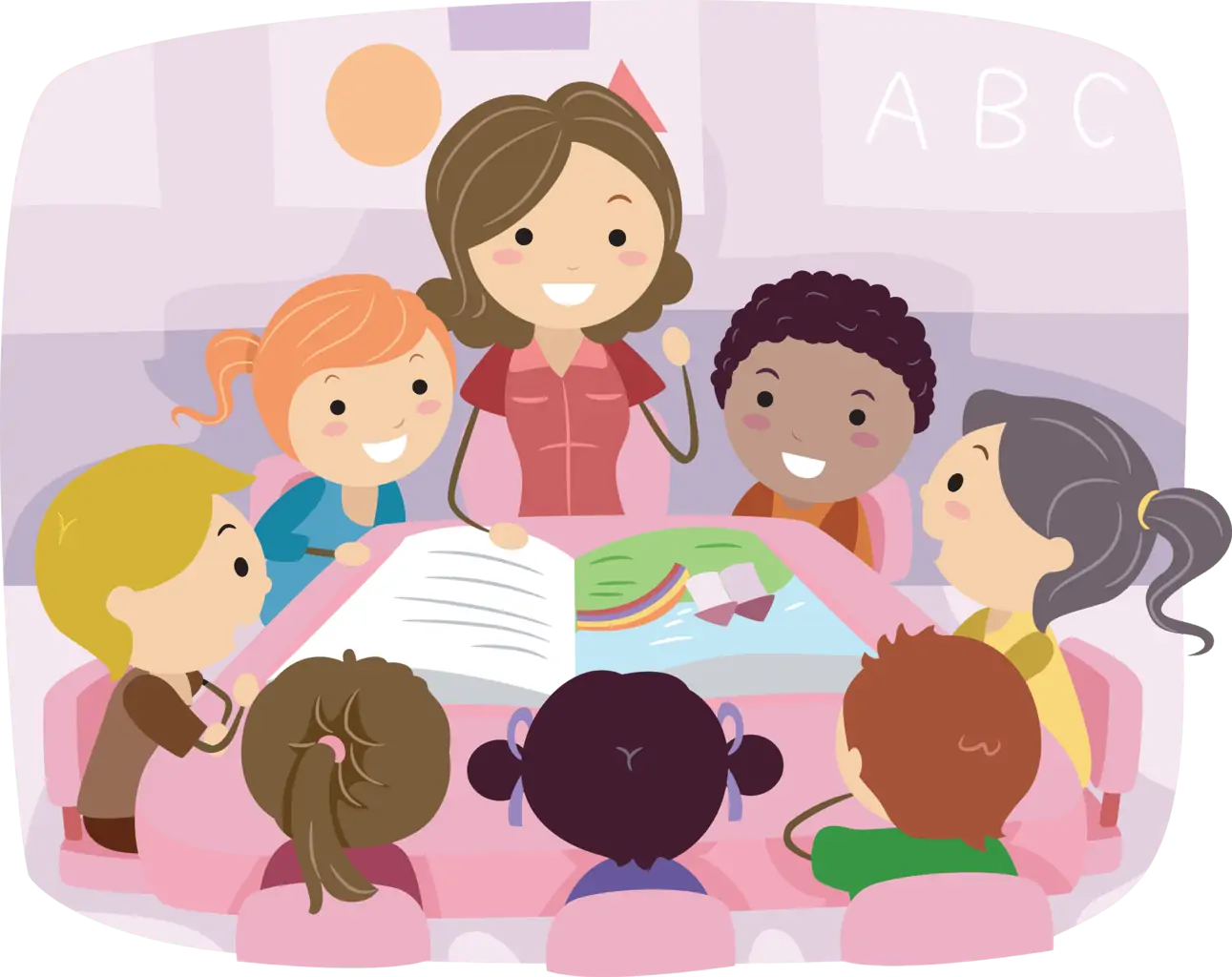
Groups
In this last variation on co-teaching, the class is separated into groups.
Group sizes vary based on the needs of the class.
You may have one large group and one small group, 2-3 equal-sized groups, or many small groups.
Instruction varies also. One teacher may pre-teach or re-teach content while the other teaches alternative information.

Bonus: Online
This has become a reality in recent times, requiring teachers to co-teach in a distance learning situation.
Many of the same methods can be implemented using screen sharing, multiple instructor c0-hosting, and/or small break-out rooms.
Co-Teaching Models in Detail

Batman and Robin
Now, if you don’t like Batman and Robin, please pretend I have entitled this model something more academic sounding.
For instance…
Andrea Honigsfeld calls this model “One Leads, One Teaches on Purpose.” For simplicity, I will also group together a similar model called “One Teaches, One Assesses” because the two models have a similar structure: one teacher is in a lead role and the other is in a supporting role.
It’s simply a question of what the supporting teacher’s role happens to be.
This is a wonderful model for helping English learners comprehend what is going on in the classroom, but it should not be overused (more on that in a minute).
A co-teacher in a more active supporting role can…
- draw pictures
- translate
- simplify
- answer questions
- point out relevant sections in a text
- ask the lead teacher to clarify something
A co-teacher in a more passive supporting role can…
- observe students and take notes
- make informal assessments of students’ understanding and progress
- provide feedback to the lead teacher on the effectiveness of a lesson’s activities
There are many different scaffolds that teachers in a supporting role can provide students while the lead teacher teaches. The goal is to help English learners, or anyone needing more sheltered instruction, to access the grade-level material the class is learning.
For more scaffolding ideas, check out this article on How to Scaffold Instruction for English Learners.
There are some challenges and drawbacks to this model as well.
Without healthy co-planning, this Batman and Robin co-teaching model can quickly become Batman and… Alfred.
If for instance…
- Batman doesn’t listen to Alfred’s advice.
- Or Batman doesn’t let Alfred in on Batman’s plans.
- Or Alfred waits around with nothing to do while Batman is out fighting crime.
Well…you get the idea.
As I mentioned earlier, teachers are wonderful, but they are also a little territorial. Without good communication and co-planning, the ESL teacher can be relegated to the role of babysitter rendering, in the words of Andrea Honigsfeld, “instructional Band-Aids to already academically challenged ELs.” (Co-Teaching for English Learners p 59)
We want more out of our co-teaching experiences in the classroom not only for our students, but also for ourselves.
Also, this model is easily overused.
Even when not co-teaching, many teachers default to doing much of the talking in a class. That is a mistake, regardless of whether they are teaching native speakers, English learners, or anyone else.
All students need to…
- use academic language
- explore concepts
- struggle productively
- communicate ideas
…in order to learn.
A classroom where two teachers hog all of the attention will fail just as quickly as a single teacher who hogs all of the attention.
In any class…
- keep “lectures” to a minimum
- get lots of interaction from all of the students (not just the strong ones)
- set them challenges to complete so that they actually have a chance to dig their teeth into something

Tag-Team
That brings us to our second co-teaching model: the tag-team.
Like tag-team wrestlers, teachers figuratively, or literally (which would be awesome), “tag each other in” as the lead.
They take turns sharing the presentation of the class material to the students.
Roles can be divided up however teachers feel most appropriate based on their strengths. A content teacher may take the content objective while the English language specialist takes the language objective for instance. Or, both take both, in a sort of teaching dance.
Either way, if coordinated well, this can be highly effective and engaging for the students.
BUT…
If coordinated badly, this can be highly awkward and miserable for everyone in the room.
This of course requires the two teachers to work together well, respecting each other’s space and expertise, giving each other room to be themselves, and focusing on what is best for the students–not what is best for their egos. In Honigsfeld’s words, “In this model, it is more important than ever before that both teachers leave their egos at the classroom door.”
That may be easier said than done depending on the teachers you need to work with. We’ll discuss issues of communication and problem-solving below.
Again, as mentioned above, too much “teacher talk” isn’t best for our students, so we need to be careful that we aren’t spending the bulk of our class time doing something that will only really benefit our stronger students.
You can grab some free Co-Planning Forms for Teacher Collaboration below to help you work together with your co-teacher to create effective lesson plans.

Groups
Groups are one of the best ways to create meaningful interaction with material in the classroom, and there are manifold ways to organize your groups.
- Pre-Teaching & Alternative Content: One teacher pre-teaches or re-teaches content to one group while the other teacher teaches alternative content to another group.
- Small Groups: Students split up into small groups of 2-3 students, and all students are working on the same task. Teachers can go around to assist English learners or other struggling students or groups.
- Stations: Stations can be set up and small groups rotate around the stations. One teacher could be at a language objective station while the other is at a content objective station. Third or fourth independent stations can be set up where students need to complete a task independently.
These are the basic ways to set up co-teaching in your classes. I have tried to summarize them in order to make the options clear. If you’d like to dig into the details more for each style, pick up Andrea Honigsfeld’s book Co-Teaching for English Learners.

Online
This is one type of co-teaching that has only really come into existence recently due to school closures.
The best methods I’ve heard so far came from Jody Nolf. She offered up two excellent options:
- Co-teacher attends a live meet, then “pulls” kids afterwards for small group instruction based on the lesson.
- Co-teacher hosts “office hours” to go over specific lessons either one-on-one or in small groups.
If you need more tips and resources for teaching online, visit this page.

Working Through Co-Teaching Challenges
Alright, let’s lay it on the table…
Co-teaching only works if you have a good relationship with your co-teacher.
If you don’t…
…it can be miserable.
I love teachers. I love their passion. I love their self-sacrifice. I love their ability to inspire a future generation.
But teachers have their problems too…just like everyone else.
One of the biggest problems I see affecting teachers’ ability to be better teachers or co-teachers is their pride.
As teachers, we all want to believe that we…
- are doing what’s best for our students
- are good at our jobs
- are making a difference
All of us also want…
- Affirmation for the results we are getting
- Respect for our thoughts and ideas
- Props for our mad teaching skills
This is all very normal…and human.
It only becomes an issue when something happens that…
- Contradicts our belief that we are anything but amazing
- Disappoints our expectation of receiving praise or affirmation
If, for instance, our students do poorly on a test, or someone gives us some critical feedback, or something doesn’t go according to plan, or a co-teacher isn’t as sold on my brilliant idea as I am, it causes cognitive dissonance.
With a co-teacher…
…you have two personalities both vying for the same affirmation, the same respect, the same classroom equivalent of a mic drop.
In order to avoid conflict and create healthy classroom experiences, some things need to happen.
Let’s take a look.
Expectations – Teachers need to honestly share their expectations about what they want to do, what they like to do, what their strengths are, what their most important values are.
Compromises – Both teachers are going to need to make compromises to accommodate the other. There will be times when this process is fair and reasonable, and there will be times when it’s not. One teacher may need to make more compromises than the other simply because the other isn’t willing. You can work towards a more equally balanced partnership with time, but it may not be easy or immediate.
Feedback – Teachers both need to be able to provide feedback to the other. In a perfect co-teaching relationship, both individuals would be able to give and take feedback graciously and grow professionally as a result. In reality, people are pretty defensive. If you have a co-teacher who doesn’t take feedback well, choose your battles and try sandwiching. First, choose your battles. Choose the one thing that you think will make the biggest difference and the other teacher is likely to understand, and let everything else go for the time being. You can give them feedback on other issues at a later date. Second, sandwich your feedback. When you sandwich your feedback, you provide positive feedback beforehand and follow up with positive feedback afterward, sandwiching the more critical feedback in between. Also, you can make your critical feedback far more palatable by finding any small instance of when the teacher did what you were hoping for, regardless of how insignificant, and then lavish praise on that behavior, telling them how amazing it would be if they were to do more of that.
Boundaries – Both teachers need to split up responsibilities, do their best to hold up their end of the deal and realize that the other person’s decisions, at the end of the day, are outside of your control. You can talk with them about it, you can share with them about how you think things could be improved, you can be patient with them, giving them space and time, but you cannot take responsibility for their decisions or behavior.
You have to let go of what is outside of your control.
There are going to be differences among teachers and at times those differences are going to involve strongly-held views.
Some teachers dig in their heels because they believe it’s what’s best for their students. Others dig in their heels because they want to be right; they want to be the one with the good idea; they want to be the center of attention.
That may mean that they say one thing and do another. They may get defensive and accusatory when things don’t go as well as they’d hoped. They may be unwilling to compromise even when it is clear that compromise is the only way forward.
But don’t give up.
Even the most difficult teachers are difficult for reasons; You just may not know or understand what those reasons are yet. But if you are patient, and kind, and generous, you will likely find your way into a co-teaching arrangement that benefits and blesses both the teachers and the students.
We are better together.
Resources

FREE Co-Planning Pack
Click below to grab a FREE Co-Planning Forms Pack for lesson planning with a colleague.
Jody Nolf’s #CollabChat Videos – See experts in action! Jody is wonderfully helpful. She has other resources on her site and you can connect with her on Twitter and Facebook.
Andrea Honigsfeld – You’ll find links to all of Andrea’s books and social media. She is the go-to person on collaboration.
Edutopia Article on How to Choose a Co-Teaching Model
Facebook Group –Engaging ELLs – ESL Teaching Resources for K-12 (Great post below from the group on co-teaching supplies.)

ESL Curriculum Membership – Sign Up Now ->

